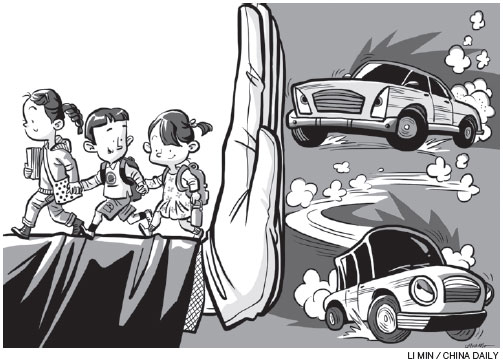
World Health Organization estimates that more than 200,000 people die on the roads in China every year. And tragically, many involve children. These deaths are entirely preventable
Most people assume that the biggest killers of children and young people around the world are diseases like malaria, diarrhoea and HIV. Right? Wrong. One of the biggest causes of death and serious injury for young people around the world is road crashes.
In China, over 10,000 children under 15 years of age die each year as a result of injuries sustained in a road crash. Many more are severely injured.
Many young victims are poor. Rates of road traffic death among children are three times higher in low-income countries than high-income countries, and road crashes can often result in poor families being plunged even further into poverty. Road safety is not just an issue with implications for the health system, then - it must also be part of global discussions about reducing poverty.
The need to keep roads safe for our children must also be taken into account in urban planning. Globally, and in China, around one-third of child road traffic victims are pedestrians. These are just kids doing what kids do: walking to and from school, playing with their friends in the street. Road design needs to take into account the needs of the communities that the roads pass through.
Making kids safe on roads is also important in promoting healthy lifestyles. The walking, cycling and other physical activity that can curb excess weight and obesity in children will inevitably bring them into contact with the road.
Countries with strong road safety laws, stringent law enforcement, appropriate road and vehicle safety enhancements and good emergency care services have had much success in reducing death on the roads. In China, some progress is being made. Statistics from the Ministry of Public Security show a downward trend in road fatalities over the last decade.
More recently, the government has moved to criminalize drink-driving. And just this year, China's State Council endorsed the Highway Safety to Cherish Life project - an important initiative which will make safety improvements to roads that millions of Chinese children travel on each day.
But much more needs to be done to spur the adoption of measures to raise road safety, especially with respect to children. While no single action can fully address all the risks, there are proven strategies for keeping people - including children - safe on the roads.
These include: speed controls; zero tolerance for drinking and driving; strictly enforcing use of helmets for bicyclists and motorcyclists; mandatory seatbelts for all passengers, and car seats for young children; improving pedestrian safety; enhancing the safety features that are built into road infrastructure; making vehicles safer; and making drivers safer - for example through graduated driver licensing programs.
Enacting this full package of strategies in China would be a huge step forward. But of course, it is not enough to adopt laws. They must also be properly and rigorously enforced: the best road safety law in the world will achieve anything if it is not enforced well. Seatbelt laws don't help save children's lives if police don't enforce them. And the starting point must be with lawmakers and enforcers leading by example.
This year's UN Global Road Safety Week falls at the half-way mark of the UN's Decade of Action for Road Safety. Only through sustained action to improve road safety - including action to Save Kids Lives - will the Decade's target of saving 5 million lives be achieved.
While entirely eliminating risk from roads won't happen overnight, it can be done over time. With the right actions implemented in a timely manner, China can reduce road injuries and fatalities. Doing all that is possible to keep children safe on the roads is surely a hallmark of any civilized society. China's children deserve nothing less.
The author is World Health Organization Representative in China.